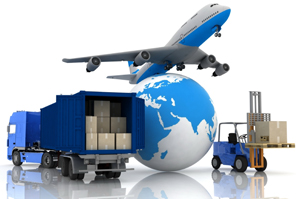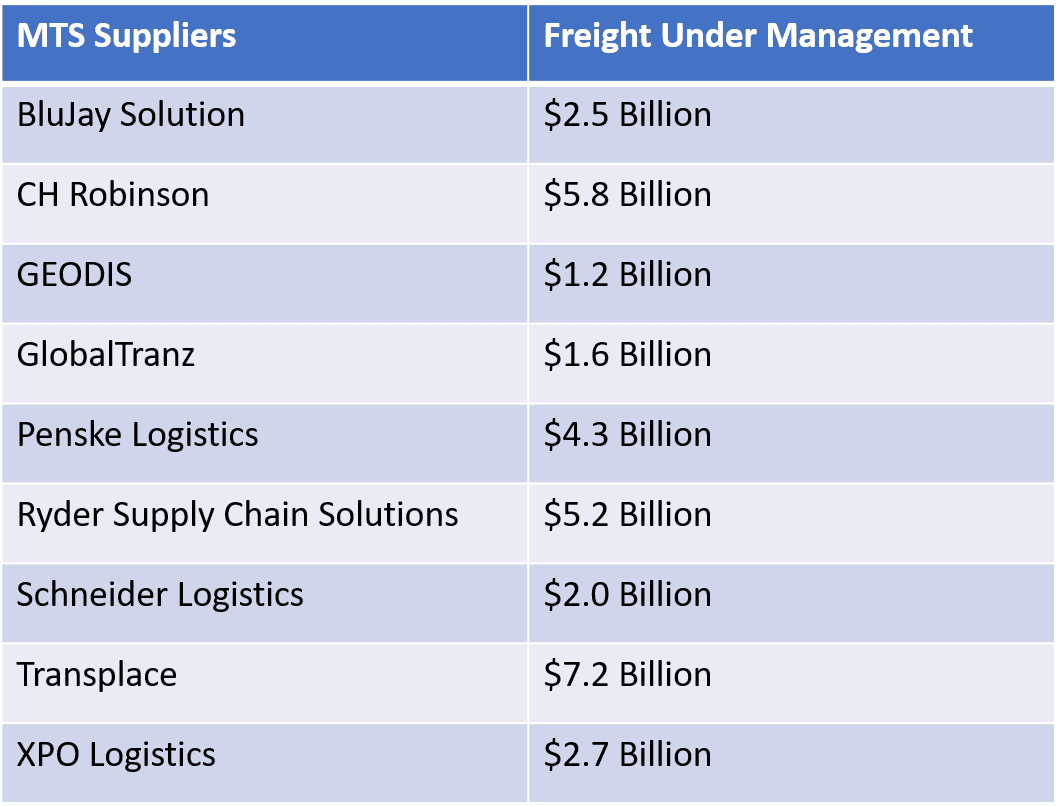 I recently wrapped up my Managed Transportation Services market study which looks at the total size of the market, the forecasted growth through 2023, and the leading suppliers across a number of categories including industry, region, and customer size. In an MTS arrangement, a shipper contracts with a third party to plan and execute their moves for them. In other words, instead of having internal planners plan and execute moves, those planners are employed by the MTS supplier, but work on the shipper’s behalf. While growth has slowed considerably in the 3PL market as a whole, this segment of the market is one of the fastest growing of all 3PL service lines, although from a much, much smaller base than carriage, brokerage, forwarding, or warehousing services.
I recently wrapped up my Managed Transportation Services market study which looks at the total size of the market, the forecasted growth through 2023, and the leading suppliers across a number of categories including industry, region, and customer size. In an MTS arrangement, a shipper contracts with a third party to plan and execute their moves for them. In other words, instead of having internal planners plan and execute moves, those planners are employed by the MTS supplier, but work on the shipper’s behalf. While growth has slowed considerably in the 3PL market as a whole, this segment of the market is one of the fastest growing of all 3PL service lines, although from a much, much smaller base than carriage, brokerage, forwarding, or warehousing services.
There are a number of key growth drivers for the MTS market including the strong ROI attached to these arrangements, the rapidly improving technology of MTS suppliers, the need for real-time visibility and accurate ETAs, and the fact that the MTS market is massively underpenetrated. Even with this last fact, the amount of freight under management in MTS arrangements is quite high. The following table is estimated freight under management (FUM) of some of the largest MTS providers.
 MTS Trends
MTS Trends
I was recently interviewed by ARC Advisory Group’s Allen Avery to take a deeper look into some of the larger trends in the MTS market. The full interview is below.
One of the biggest questions is around the key trends driving customers to explore an MTS arrangement. While there are a number of key trends, I will highlight three main ones here. First and foremost, freight spend requirements for engaging in an MTS arrangement have changed. Just a few years ago, the majority of MTS arrangements sold to shippers with freight spend over $100 million. These large customers demanded a customized solution, which is just not the case today. Instead, most MTS providers have standardized on one TMS and do not customize that solution. This results in speedier and lower cost implementations. Lower costs increase the ability to sell MTS to smaller customers, especially those in the $25-100 million and $5–25 million freight spend segments. These two segments are now considerably larger than the freight spend of over $100 million category.
Second, is the decision of whether to bring transportation management in-house or outsource it to an MTS provider. The freight savings and service improvements associated with TMS are quite similar to MTS arrangements. However, many shippers lack network design capabilities or a continuous improvement culture. Many MTS providers have expertise in these two areas, which can help shippers make that decision.
Finally, cross border commerce continues to grow. While trade wars and protectionism are clearly concerns, the economy is becoming more global in nature. Many shippers simply lack the capabilities to manage cross-border transportation. This is where a managed services agreement comes into play.
There is also the question of what trends and strategies should the MTS providers be monitoring and exploring. Once again, I will highlight three items of interest. One of the most important things for MTS providers to do is invest in TMS, real-time visibility tools, BI, machine learning, and predictive analytic capabilities. Templated versions of the TMS should be developed for core verticals to speed implementations.
Second, MTS providers need to go global with their capabilities. Many suppliers are still focused on providing solutions in just North America or Europe. Truly global capabilities depend upon using one TMS solution across all regions and then having regional control towers so that shipments can be tracked on a follow-the-sun basis.
Finally, suppliers need to place a premium on service. Success depends not just upon technology, but on service capabilities as well. Top suppliers have a robust continuous improvement culture and the ability to provide advanced consulting in network design and strategic procurement. A couple of recent case studies I’ve written about Iconex (GlobalTranz customer) and Ocean Spray (CH Robinson customer) highlight just how important the service aspect is.
Final Word
The MTS market has grown steadily over the last few years and the outlook is for that growth to continue. There are several key factors that contributing to growth in the market. The significant ROI associated with MTS arrangements is the number one thing that most companies will look at. However, additional growth factors include better technology solutions, the increasing ability to provide global solutions, the changing nature of customer expectations, the advances in providing real-time visibility and shipment ETA, and the fact that the market is incredibly underpenetrated. MTS providers need to continue to invest in their solutions, with a focus on improving real-time visibility. Equally as important is the service factor. MTS suppliers need to place a premium on service, as it can be the difference maker when it comes to choosing a provider.

















